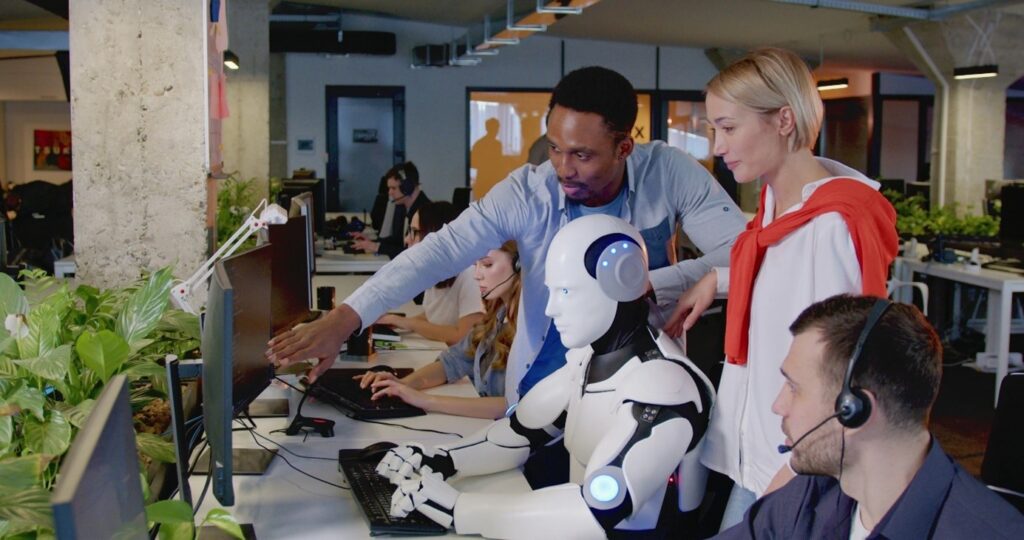It’s no secret that AI is all vogue. When you’re in the supply chain software solutions business, if you don’t have AI, you’re a has-been. Don’t worry, we’ve started to infuse a little AI to good effect in Intuiflow…
However, it’s hard for industry players to see where AI is relevant. Have you seen any real-life use cases where AI makes a difference?
A few months ago, at a Gartner conference, I attended a presentation dedicated to the importance of AI for supply chain planning – the hook of the presentation mentioned 7 practical application cases. The slides presented by the analyst were very professional and aesthetically superb… but when it came to practical cases, there was nothing concrete, only principles.
A Google search turns up pages of major consultancies describing the benefits of generative artificial intelligence in very generic terms. The example below, taken verbatim:
“Production planning AI helps plan production and scheduling, taking into account factors such as changes in customer demand, production capacity, resource availability, and order priorities. Like its demand forecasting capabilities, generative AI can develop production plans, schedule sequences and allocate resources efficiently to minimize bottlenecks and optimize production efficiency.”
Makes you wonder if it wasn’t written by the trainee using ChatGPT…
At a recent round table organized by a Supply Chain media organization in France, several software publishers discussed the subject, and listening to their discourse the common denominator was this: we must have AI, but the contributions are not so clear-cut.
Humans in the driver’s seat
The reality of our supply chains is that they are operated daily by men and women. In a way, this is reassuring.
Every day, these men and women make decisions – strategic, tactical, and operational. For example, placing an order, follow-up with a supplier, initiating a shipment, adding production teams, authorizing a capacity investment, and so on.
The challenge for companies is to ensure that these decisions, taken over time by the players in their supply chain, contribute to improving performance: better meeting customer needs, and being more profitable.
Cognitive and behavioral biases in Supply Chain
Humans are very good at supply chain decision making, provided they have the relevant information to back up those decisions. So play a simple game of beer with your team of supply chain specialists, and you’ll be amazed at just how chaotic a situation your team will generate…
We regularly host “Flow Sim Game“, a flow simulation game based on the beer game. The bullwhip effect is always impressive.
In the second phase of the game, all that’s needed is to implement a few simple management rules – a few DDMRP buffers – and the same supply chain becomes stable and adaptive.
Without AI. Simply with a well-designed formal supply chain management model.
In my experience, many companies are at this stage: they lack a well-designed operating model – supply chain teams work on energy, usually in Excel.
A change of generation
Boomers like myself have known industries without ERP systems. We saw the arrival of MRP and touched its limits. We implemented kanbans and touched their limits. We participated in globalization, and we’re not so proud of it… We learned on the job, and many of us studied theory to obtain our APICS certifications.
This generation, along with Gen X now in its fifties, is giving way to Millenials and Gen Z, who are now in the driver’s seat when it comes to managing supply chains. These generations often have a solid theoretical education in supply chain management, which we didn’t have. They are comfortable with digital tools. But they haven’t lived through the advent of planning methods, and don’t always have the critical sense to question technological promises.
How can you benefit from AI?
To help this new generation of planners and decision-makers, we must first put the design of the operating model at the forefront. Without a well-designed operating model and relevant management rules, the supply chain will be neither agile nor resilient.
In this design phase, the impact of AI is marginal – it is above all important to have well-trained teams who adopt a systemic approach, and who are supported by the company’s leadership.
Once the model has been designed and equipped, AI can begin to play its role as co-pilot: facilitating the automation of routine tasks, and the rapid management of a mass of data, so that the men and women at the helm can make the right arbitrations.
Before considering AI, focus on designing an agile and resilient supply chain!












